The Economics and Statistics Division maintains archives of previous publications for accountability purposes, but makes no updates to keep these documents current with the latest data revisions from Statistics Canada. As a result, information in older documents may not be accurate. Please exercise caution when referring to older documents. For the latest information and historical data, please contact the individual listed to the right.
<--- Return to Archive
For additional information relating to this article, please contact:
January 17, 2023ANALYSIS OF NOVA SCOTIA'S CONSUMER PRICE INDEX FOR DECEMBER & ANNUAL 2022 TRENDS – December & Annual 2022
Nova Scotia’s All-Items Consumer Price Index (CPI) increased 7.6% year-over-year in December 2022. Inflation rate in Nova Scotia has been fluctuating since peaking at 9.3% in June 2022. Nationally, consumer prices increased 6.3% year over year in December, following a 6.8% increase in November 2022.
Inflation was highest in Manitoba (+8.0%) while Newfoundland and Labrador (+5.7%) had the lowest.
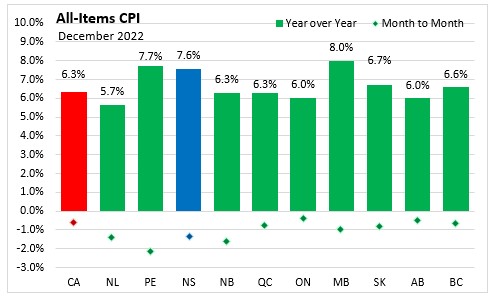
Comparing the average of CPI in 2022 with the average in 2021, all-items CPI increased by 7.5% in Nova Scotia. National all-items CPI was up 6.8% in 2022, a 40-year high and the largest increase since 1982 (+10.9%). In Halifax, all-items CPI grew 7.3%.
Nationally, price increases were broad-based in 2022, with prices up on an annual average basis in all eight major components. Both goods and services prices rose at a faster pace compared with a year earlier. Prices for goods were up 8.7% on an annual average basis in 2022, led by higher prices for non-durable goods such as food purchased from stores (+9.8%) and gasoline (+28.5%). Prices for services increased 5.0% in 2022, led by homeowners' replacement cost (+9.5%) and other owned accommodation expenses (+10.0%).
All provinces recorded higher annual average prices in 2022. The largest increase was recorded in Prince Edward Island (+8.8%) while Alberta and Newfoundland and Labrador recorded the slowest increase (both at 6.4%).

The CPI for food in Nova Scotia increased 9.9% in December, down from the 11.5% year-over-year increase recorded in November. All provinces recorded year-over-year increase in food prices led by Manitoba (+12.1%). The lowest inflation was reported in New Brunswick and British Columbia (both at 9.5%).
Nationally, food prices rose (+10.1%) in December 2022 on a year-over-year basis. Prices in December rose at a slower pace for a number of food items, including non-alcoholic beverages (+16.6%), bakery products (+13.5%), coffee and tea (+13.2%), other food preparations (+11.5%) and preserved fruit and fruit preparations (+7.2%). Slowing price growth for groceries was offset by prices for fresh vegetables, which rose 13.6% in December following an 11.2% increase in November.
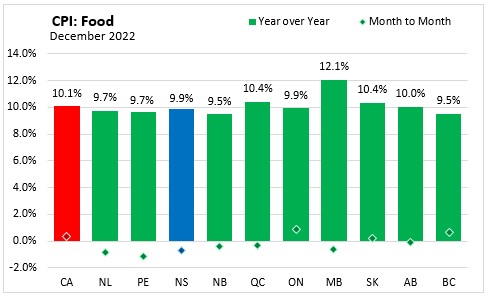
In 2022, food prices in Nova Scotia increased 9.1% from the previous year, following a 2.4% increase recorded in 2021. Nationally food prices were up 8.9% when compared to 2021 with all provinces reporting year-over-year increases. The largest increase in food prices was recorded in Prince Edward Island (+9.7%) while British Columbia reported the slowest gain (+8.0%) in 2022.
Prices for food purchased from stores rose 9.8% in 2022, the fastest pace since 1981 (+12.0%), after increasing 2.2% in 2021. Food inflation was broad-based in 2022, with prices increasing on an annual average basis in every food category except for canned salmon (-1.4%).
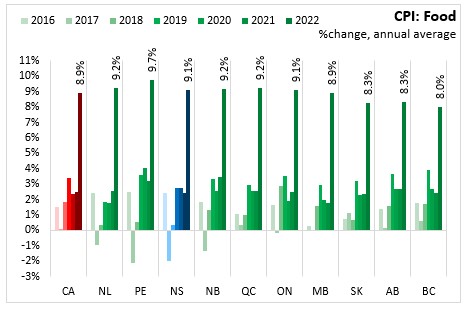
Year-over-year, shelter costs in Nova Scotia increased 9.2% in December 2022.
In December, shelter prices increased 7.0% year-over-year across Canada. With increasing interest rates, mortgage interest costs increased 18.0% year-over-year in December. The homeowners' replacement cost index, which is related to the price of new homes, slowed in December (+4.7%) after increasing 5.8% in November. This index has decelerated, on a year-over-year basis, every month since May 2022 (+11.1%).
Compared to December 2021, shelter prices were up in all provinces with the largest increase in Prince Edward Island (+12.1%) and the smallest increase in Ontario (+6.5%).
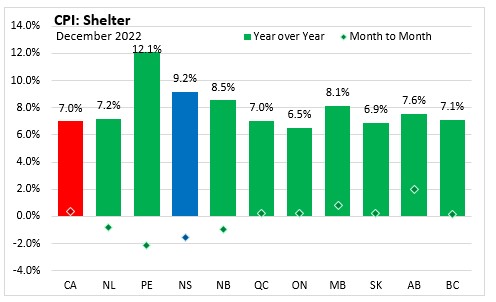
Nova Scotia shelter prices rose 8.5% in 2022, following a 4.8% increase recorded in 2021. Canada shelter costs rose 6.9% led by higher prices for homeowners' replacement cost (+9.5%). Shelter price increases were largest in Prince Edward Island (+12.8%), followed by Nova Scotia. Homeowners' replacement costs increased faster than rent prices (+4.6%).
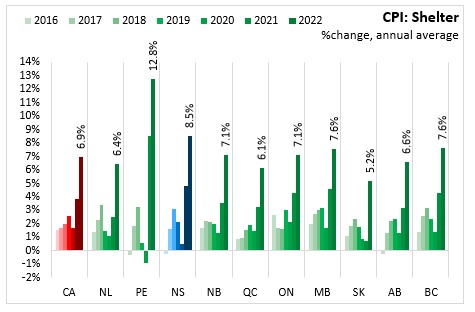
Nova Scotia's consumer price inflation (year-over-year growth in CPI) for energy was 16.9% in December, above the national average of 7.3%. Prince Edward Island (+22.1%) posted the largest year-over-year increases while Alberta (+0.1%) had the smallest change in the energy index.
Energy prices were lower in all provinces compared to November 2022. For Canada, consumers paid 13.1% less in gasoline in December compared with November, the largest monthly decline since April 2020.

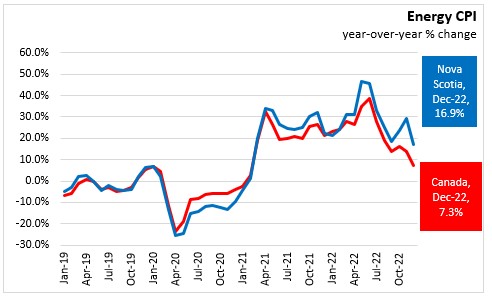
Consumers in Nova Scotia paid on average 28.9% more on energy in 2022 when compared to the previous year, following a 21.7% increase recorded in 2021. Nationally, energy prices increased 22.5% year-over-year in 2022, led by Prince Edward Island (+37.5%).
Higher energy prices (+22.5%) was the main driver of headline inflation in 2022. Gasoline prices increased 28.5% on an annual average basis as a result of supply uncertainty due to Russia's invasion of Ukraine and higher demand in response to the easing of COVID-19 restrictions.
Prices for fuel oil and other fuels rose 59.6% on an annual average basis in 2022, following a 24.4% gain in 2021. Atlantic Canadians were most impacted by this increase, as fuel oil is more commonly used for heating homes in Atlantic Canada.
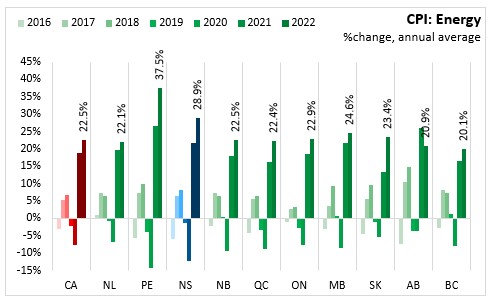
Nova Scotia’s consumer price inflation (year-over-year) excluding food and energy increased 5.7% in December 2022. Consumer prices excluding food and energy were up in all provinces led by Manitoba (+6.6%) and British Columbia (+6.0%). Newfoundland and Labrador had the smallest increase at 3.9%.
For Canada, consumer price inflation excluding food and energy increased 5.3% year-over-year in December, following a gain of 5.4% in November.

The CPI excluding food and energy increased 4.3% in Nova Scotia, lower than the national average of 5.0% in 2022. Manitoba (+5.9%) had the largest increase for the CPI excluding food and energy while the smallest increase was in Newfoundland and Labrador (+3.1%).
Average annual price increase excluding food and energy was faster in every province in 2022 compared to last year.
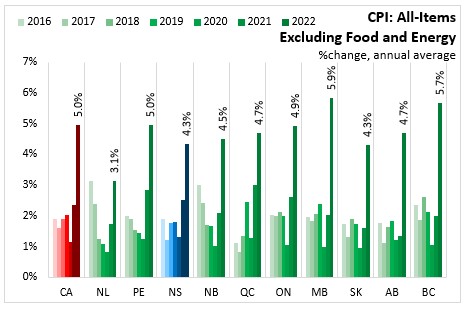
Major Components for December 2022
The following table shows the price increases specific to Nova Scotia for the major components of the CPI this month.
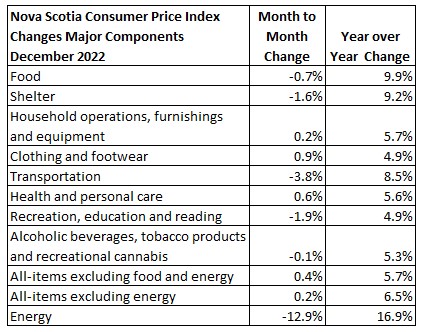
The main contributors to the monthly change (December 2022 vs November 2022) in Nova Scotia CPI were:
- Rent (+2.2%)
- Homeowners' home and mortgage insurance (+5.1%)
- Internet access services (200212=100) (+8.5%)
- Gasoline (-15.3%)
- Fuel oil and other fuels (-19.5%)
- Purchase and operation of recreational vehicles (-5.2%)
The main contributors to the yearly change (December 2022 vs December 2021) in Nova Scotia CPI were:
- Fuel oil and other fuels (+52.3%)
- Purchase and leasing of passenger vehicles (+7.5%)
- Gasoline (+10.1%)
- Child care and housekeeping services (-11.3%)
- Home entertainment equipment, parts and services (-2.9%)
- Other household supplies (no % change but downward pressure)
Major Components for 2022
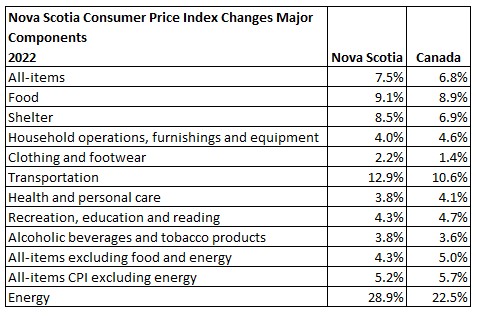
For Nova Scotia, prices increased in all of the eight major components of the consumer price index in 2022. The fastest growing prices for Nova Scotia were in energy (+28.9%) and transportation (+12.9%), both of which grew faster than Canadian average. Health and personal care (+3.8%) inflation was slower than Canada (+4.1%) as was the case in household operations, furnishings and equipment inflation (+4.0% in Nova Scotia vs +4.6% in Canada).
Long Run Trends
In December 2022, the all-items CPI year-over-year inflation rate for Nova Scotia was 7.6%, above the national inflation rate of 6.3%.
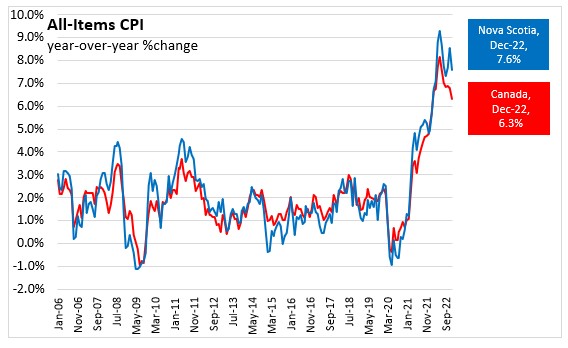
Nova Scotia’s CPI excluding food and energy increased 5.7%. Canada CPI excluding food and energy rose 5.3%. The Nova Scotia CPI excluding food and energy was previously higher in March 2003 (+5.1%).
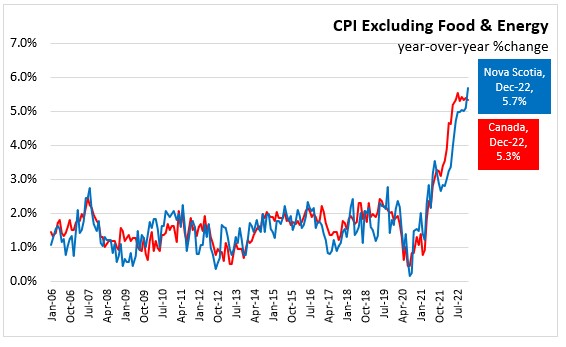
Bank of Canada's preferred measures of core inflation
Compared to December 2021, CPI-Common increased 6.6%, CPI-Median increased 5.0% and CPI-Trim was up 5.3% in Canada. All-items CPI excluding eight of the most volatile components as defined by the Bank of Canada and excluding the effect of changes in indirect taxes (formerly referred to as CPIX), rose 5.4% year-over-year. The change in the core inflation measures was down 0.2 percentage points for CPI-common, and down 0.1 percentage points for both CPI-median and CPI-trim from the previous 12-month period.
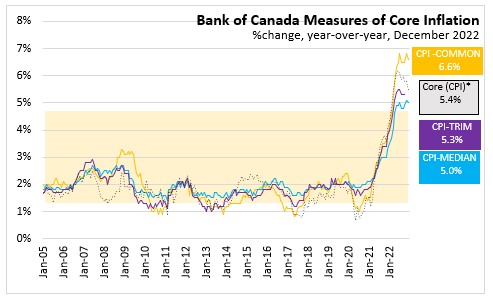
Appendix Tables and Charts

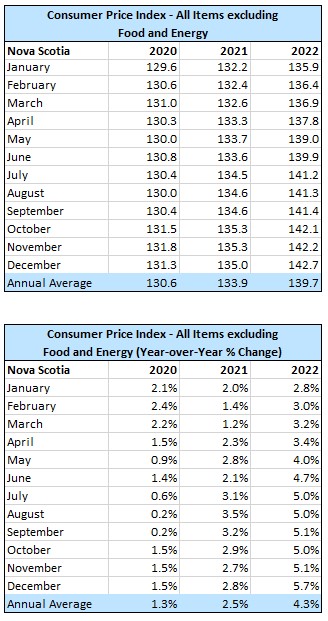
Basket Update - May 2022
As part of schedule update, Statistics Canada has updated the basket weights based on 2021 expenditures. A used vehicle price was introduced into the CPI Compared to the previous basket reference year of 2020 for Nova Scotia, increase weight for transportation (+2.04 percentage points) and clothing and footwear (+0.52 percentage points) were offset by lower weights for food (-0.5 percentage points), shelter (-0.53 percentage points), health and personal care (-0.65 percentage points) and recreation, education and reading (-0.5 percentage points). Statistics Canada noted that at national level the headline CPI growth rate would be the same using the previous weights. For full details on the weight update, see An Analysis of the 2022 Consumer Price Index Basket Update, Based on 2021 Expenditures.
Source: Statistics Canada. Table 18-10-0004-01 Consumer Price Index, monthly, not seasonally adjusted; Table 18-10-0005-01 Consumer Price Index, annual average, not seasonally adjusted; Table 18-10-0256-01 Consumer Price Index (CPI) statistics, measures of core inflation and other related statistics - Bank of Canada definitions
<--- Return to Archive